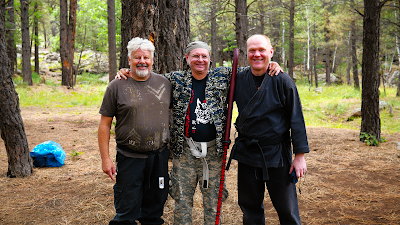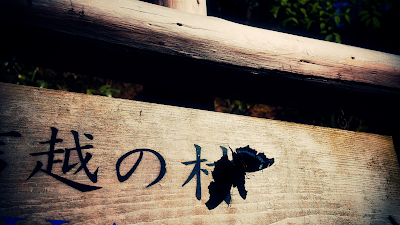From Bujinkan Santa Monica by Michael
 |
| Robert, Peter, and Michael in the Forest of AZ |
I went to the annual Arizona Bujinkan campout in the mountains of the Coconino national forest. This is an event I have been participating in for more than 20 years. Big thanks to my teacher, Peter Crocoll, and all of my friends in AZ who welcome me back home every year.
After an 8-9 hour drive from Santa Monica, we arrived mid afternoon to our campsite of over 7000 ft elevation. We set up camp quickly because this time of year, afternoon rain showers are common. But the rain came in the evening.
Heavy and loud with lightning. But I was happy to curl up in my sleeping bag in the cold mountain air for some rest. Adjusting my heart and lungs from sea level can be hard work.
During the night, the rain broke. I woke up with moonlight illuminating my tent. I saw a movement out of the corner of my eye. There was a dark silhouette crawling up the wall. I thought a big insect had gotten inside so I poked at it. It was a tiny frog!
The next morning, I had a very early hike. Then my student, Robert Grove prepared a very hearty breakfast. It turns out I didn’t need to pack any food at all, because he was quite the camp chef.
My teacher, Peter Crocoll began the morning session with nagamaki kihon. Then we moved into some bisento kata he did with Someya Sensei in Japan. The nagamaki has no formal kata in the Bujinkan, so the bisento forms are a useful starting point.
I did some of these forms with Someya Sensei myself during my March Japan trip. They are short, direct, and deadly. A sword on the end of a polearm is a formidable weapon!
During the whole weekend, I would find myself getting too flashy with the weapon. I wanted to twirl, cross step, and brandish it. But Peter kept reminding me that straightforward taijutsu was the best approach. This was also my experience with Someya. This is why it is so important to remain a student, because you never see your own movement clearly.
We trained all day, then had a dinner break. Now it was time for night training. I will not reveal much about this because it is meant to be experienced.
We start when it is dusk, but still plenty of light. Peter asked me to show some muto dori I did in Japan during my recent trip in July. Then he asked my friend Nate to share some of his experience.
As the light faded, our eyes adjust. But away from the city, and out in the wilderness, it gets quite dark. The moon wasn’t rising until early morning. So the darkness was nearly absolute.
Imagine doing muto dori in these conditions. We can’t even see our opponent, much less the weapon. Soon, it did not even matter whether you were facing the opponent or not, since you cannot see even your own hands.
Some people had revelatory experiences in these conditions. I felt myself become the darkness. And that was pure fun!
Afterwards the time around the campfire roasting marshmallows was very relaxing. We shared many jokes and old training stories. Normally this goes pretty late into the night, but many people were exhausted after training all day. I stayed to put the fire out around 11 pm.
Then I went for a solo hike in the blackness. No flashlights. Just pure sensory blending with the dark forest.
Later that night, I awoke in my tent to find the moonlight streaming in. The tiny frog was crawling up the outside of my tent again. I must have parked my tent on top of his home! or maybe he just liked all the dew that condensed on the fabric of my tent.
Next morning, I was up quite early for a hike. Robert again prepared a great and hearty breakfast. I told him that I decided he must come along on all of the camping trips!
Peter continued with bisento waza using the nagamaki. He showed the basic form and the ura waza. Peter takes detailed and extensive notes during his Japan trips. So he always shares the little details that reveal the secrets of our art.
I gave Robert a surprise promotion to nidan. He performed well in this stressful ambush I prepared for him. He already had a shodan from another dojo when he started training with me a year ago. But his martial arts background goes back more than 30 years.
It was hard to say goodbye to my friends (really more like family). And the mountain forest. Training in this environment brings me a bit closer to the experiences of my ninja ancestors from the mountains of Japan.

…







